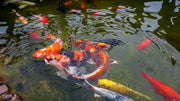
Imagine strolling past your backyard pond five summers from now. The tiny, hand-sized koi you bought today now glide beneath the water-lilies like living torpedoes—bold, confident, and nearly two feet long. If you didn’t plan for that growth, they might already be crowding your pond, overloading pond filters, and flirting with disease. Knowing how big do koi get is the foundation of every good pond design, feeding schedule, and equipment choice you’ll make.
This guide breaks down the average sizes of standard and butterfly koi, the factors that drive—or stunt—their growth, a realistic growth timeline, common size myths, and practical pond-planning tips— including why a properly sized Poposoap solar pond filter is among the smartest investments you can make for fish that could share your garden for decades.
Why Koi Size Matters
Koi aren’t just decorative; they’re carp bred to grow—sometimes dramatically. Size affects:
- Water volume needs – Larger bodies expel more waste and consume more oxygen.
- Filter capacity – Bio-media must neutralize higher ammonia loads as koi mature.
- Pond depth & surface area – Big koi need room to turn without scraping scales.
- Predator protection – A heron that gulps a six-inch juvenile may back off from a twenty-four-inch adult.
- Budget – Food, filtration upgrades, and even heating costs climb with every extra inch of fish.
Ignoring growth today all but guarantees costly retrofits tomorrow.
Average Size of Koi Fish

- Standard koi carp usually finish between 24 – 28 inches (60 – 70 cm) in well-managed outdoor ponds.
- Jumbo bloodlines can surpass 30 inches (75 cm) and 20 lb (9 kg).
- Butterfly koi often reach 20 – 26 inches (50 – 65 cm) in body length; flowing fins make them look even larger.
So if you’re asking how big do koi fish get or how big do butterfly koi get, plan for at least a two-foot fish and the water volume to match.
Factors That Influence Koi Growth
- Genetics – Bloodline sets the ceiling; ask breeders how large the parents grew.
- Water quality & filtration – Even slight ammonia stalls appetite. A Poposoap multi-stage solar pond filter turns pond water every one to two hours without raising your utility bill, keeping ammonia at 0 ppm.
- Diet & feeding frequency – High-protein pellets (summer) and wheat-germ diets (cool seasons) fuel steady length, not fat.
- Temperature & season length – Growth surges at 21–26 °C (70–78 °F); longer warm seasons yield bigger fish.
- Stocking density – Crowding steals oxygen and stunts growth even when tests look “okay.”
- Pond depth & current – Depths of 90–120 cm with gentle flow from a Poposoap waterfall spillway strengthen muscles and encourage healthy appetite.
Koi Growth Timeline

Growth is fastest in the first few years, then slows as koi bulk out:
- By three months they measure about 7–10 cm (3–4 in) as fry rapidly develop organs and color.
- Around one year they generally reach 15–20 cm (6–8 in); patterns stabilize though sexual organs remain immature.
- At two years a healthy koi can jump to 30–40 cm (12–16 in) during its major growth spurt, provided nutrition and filtration keep pace.
- Between years three and four most well-kept koi stretch into the 45–60 cm (18–24 in) range and reach breeding age; length increases slow, but girth builds.
- From the fifth year onward they may add only a few centimeters annually, yet selected jumbo lines can eventually exceed 75 cm (30 in) and continue filling out for life.
Water temperature, diet, and overall husbandry can advance or delay each milestone by up to a year.
Myths About Koi Size
- “A koi only grows as big as its pond.”
False. Small ponds stunt koi because of poor water quality, not magic size-limiting hormones. Provide pristine, filtered water and the fish resumes growing.
- “Butterfly koi stay small.”
Their bodies can be nearly as long as standard koi; the extravagant fins just exaggerate length. Plan volume the same way.
- “Feed more, they’ll grow faster.”
Only if filtration and oxygen rise with intake. Overfeeding in under-filtered ponds builds fat, not healthy length, and spikes ammonia—doing the opposite of what you want.
Planning Your Pond for Full-Grown Koi

- Volume & turnover – Reserve about 250 gallons (≈ 950 L) per adult over 50 cm; circulate at least half that volume hourly. Poposoap solar pond filters scale from 120 GPH patio boxes to 580 GPH mid-size kits, each upgradeable as koi mature.
- Depth – Aim for ≥ 90 cm (3 ft) for thermal stability and predator evasion.
- Aeration – Add a solar aerator or solar powered floating fountain; dissolved oxygen above 6 mg/L keeps growth on track.
- Expandable filtration media – Poposoap modular filter boxes accept extra chambers as your koi (and bio-load) increase.
- Feeding station & observation – A calm edge lets you monitor appetite and catch problems early.
- Future plumbing stubs – Spare lines for a bog filter or extra waterfall today are cheaper than breaking concrete later.
Conclusion: Prepare Now, So Your Koi Can Thrive Later
How big do koi carp get? Big enough to demand forethought—two-foot adults are routine, three-foot giants entirely possible. Plan pond size, depth, and especially filtration around tomorrow’s fish, not today’s fingerling, and power the system with Poposoap’s solar pond filters, aerators, and spillways. Do that and your koi will reach their full, brilliant potential while your water stays crystal-clear—proof that smart planning beats emergency upgrades every time.










